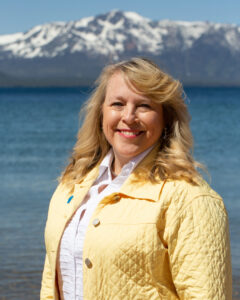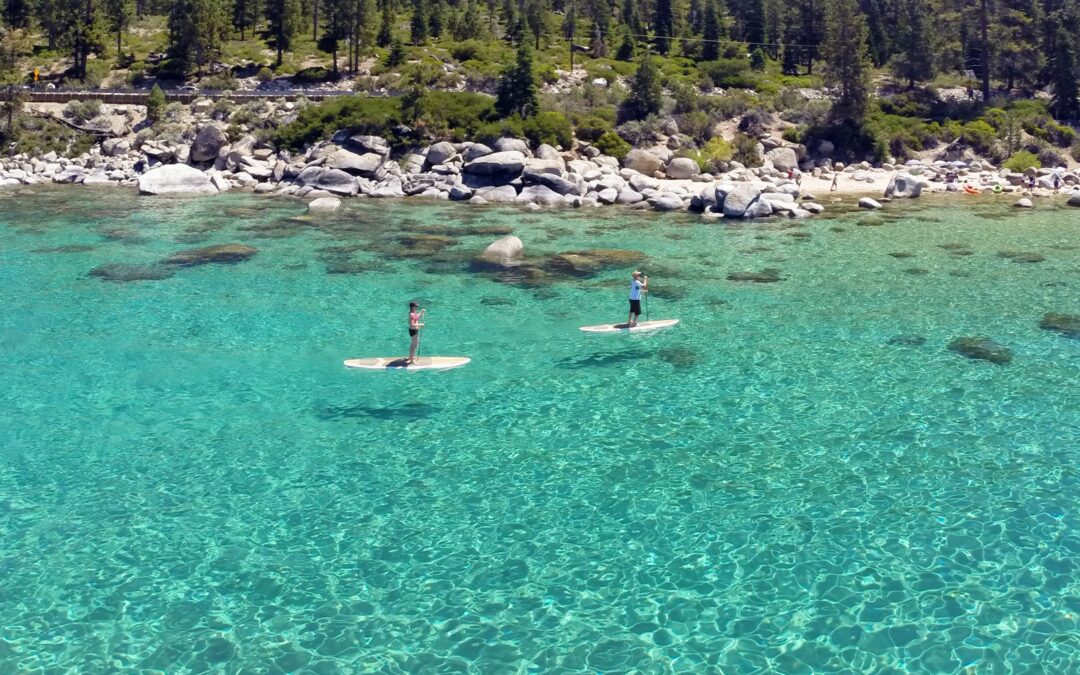By Julie Regan

Julie Regan is Executive Director of the Tahoe Regional Planning Agency.
It feels like it was just a short time ago that this year’s mighty winter was still strong-arming Tahoe and the wet spring was keeping summer at bay. Now temperatures are climbing here and around the country like in Phoenix, Ariz. which earlier this week marked a record 19th straight day with heat over 110 degrees. On a different scale, climate change is impacting Lake Tahoe as well. Shoreline water temperatures hit 70 degrees this week and the lake’s average temperature is 1.4 degrees higher since 1970.
More extreme weather events like last winter’s historic storms are threatening water quality gains and underscoring the need to strengthen regional resilience.
Tahoe has no shortage of challenges. Achieving affordable housing, reducing wildfire risk, connecting Tahoe’s transportation system, and better managing recreation and tourism all require significant focus and attention, but safeguarding the health of the lake itself is a thread running throughout the Lake Tahoe Regional Plan and remains central to the work of the Tahoe Regional Planning Agency (TRPA) and our many partners.
While TRPA Regional Plan measures to limit development, manage growth, and protect and restore sensitive lands have helped stabilize lake clarity, climate change is driving emerging issues, the need for innovative science, and additional priorities for TRPA and the basin.
Stopping harmful practices that lead to a decline in clarity can only go so far. In 2010, basin partners brought forward a water quality restoration program called the Total Maximum Daily Load (TMDL) to reverse the trend and restore Lake Tahoe’s lost clarity. The study identified fine sediment and two nutrients (nitrogen and phosphorus) that help algae grow as the main culprits and helped us establish reduction targets and strategies.
A recent 10-year interim report on the TMDL is promising for the lake and our region’s climate resilience. Through stormwater Best Management Practices and other improvements, basin property owners and public agencies achieved a 23 percent reduction in pollutants. Now 600,000 lbs. of fine sediment are being kept out of the lake every year. Researchers also reported lake clarity rebounded for a short time last year to the clearest it has been in 40 years.
Meanwhile, aquatic invasive weeds and smelly, sometimes harmful, outbreaks of algae are being reported in certain areas. In addition to invasive weed control projects underway, TRPA is looking to researchers and the Tahoe Science Advisory Council for answers to algae problems.
As we increase our understanding of algae growth and explore possible connections between native microorganisms and lake clarity, there is broad agreement in the science community that advancing Lake Tahoe’s innovative pollutant reduction strategies will remain foundational even as the ecosystem reacts to rising temperatures and more extreme weather events.
Adding to water quality challenges, the lake’s vast depth and size cause it to hold particles and pollutants for a long time—650 years or more. A recent report comparing the concentration of microplastics measured in Lake Tahoe to other lakes points to this long hold time as a possible factor in the study’s findings. While the authors point to the need for additional research to understand the source and character of microplastics in Tahoe, we will continue to fight against littered beaches and local sources of plastic trash to protect the health of the lake.
Unlike fine sediment and algae-feeding nutrients, litter doesn’t require a sophisticated filtration system. It requires changes in behavior, better infrastructure, and on-the-ground management. Recent bans on single-use plastics in the City of South Lake Tahoe are positive steps forward, as is the launch last month of the first-ever Lake Tahoe Destination Stewardship Plan to better manage outdoor recreation and tourism. While overall development and capacity in the Tahoe Basin are closely managed, hotter temperatures and growing population centers are making Lake Tahoe a climate refuge, with traffic into Tahoe sometimes doubling when temps rise to 100 degrees a few hours away.
I’d like to express a special thanks to the volunteers and organizations that helped clean up our beaches after the Fourth of July this year. The mind-blowing amount of trash removed by League to Save Lake Tahoe volunteers, the TRPA Blue Crew, and Clean Up The Lake at Zephyr Shoals was more than disheartening. We must continue working together to take care of Tahoe and bring greater education, infrastructure, and enforcement to recreation sites around our precious lake.
To learn more about climate resilience and our regional water quality initiatives, visit clarity.laketahoeinfo.org.
–Julie Regan is Executive Director of the Tahoe Regional Planning Agency.

